nanotechnology I, II, III - minko
1/39
There's no tags or description
Looks like no tags are added yet.
Name | Mastery | Learn | Test | Matching | Spaced |
|---|
No study sessions yet.
40 Terms
types of cancer
each organ in the blood is composed of different types of tissue, and most cancers arise in 1 or 3 main types → epithelial, connective or blood forming tissue
carcinomas = cancer that occur in epithelial tissues
skin, inner membrane surfaces of the body (such as those of the lungs, prostate, breast, ovarian, stomach, intestines, blood vessels)
sarcomas originate in connective tissue
muscle, bone, cartilage, fat
parts that support and connect other parts of the body
leukemias develop in blood cells and lymphomas originate in the lymphatic system
ranking of prevalence
carcinomas ~90%
leukemias + lymphomas ~8%
sarcomas ~2%

nanotechnology
nanotechnology is a field of applied science focused on the design, synthesis, characterization, and application of materials and devices on the nanoscale
focused on creation and the use of materials and devices at the level of molecules and atoms
nanomedicine = offshoot of nanotechnology, refers to highly specific medical intervention at the molecular scale for curing disease or repairing damaged tissues such as bone, muscle, nerve or cells

nanotechnology scale
what is considered nanotechnology/nanomedicine
small dye molecule → 0.5 nm-10nm
fluorescent protein → 10 nm-20nm
virus → 20nm - 400 nm
atoms are SMALLER than nanotech
bacteria/animal cell are LARGER than nanotech

classes of nanoparticles
polymeric
examples
polymersome
dendrimer
polymer micelle
nanosphere
advantages
precise control of particle characteristics
payload flexibility
easy surface modifcation
disadvantages
possibility of aggregation and toxicity
inorganic
examples
silica nanoparticle
quantum dot
iron oxide nanoparticle
gold nanoparticle
advantages
unique electrical, magnetic, optical properties
variability in size, structure, geometry
suited for theranostic applications
disadvantages
toxicity and solubility limitations
lipid-based
examples
liposome
lipid nanoparticle
emulsion
advantages
formulation simplicity
high bioavailability
payload flexibility
disadvantages
limited encapsulation efficiency
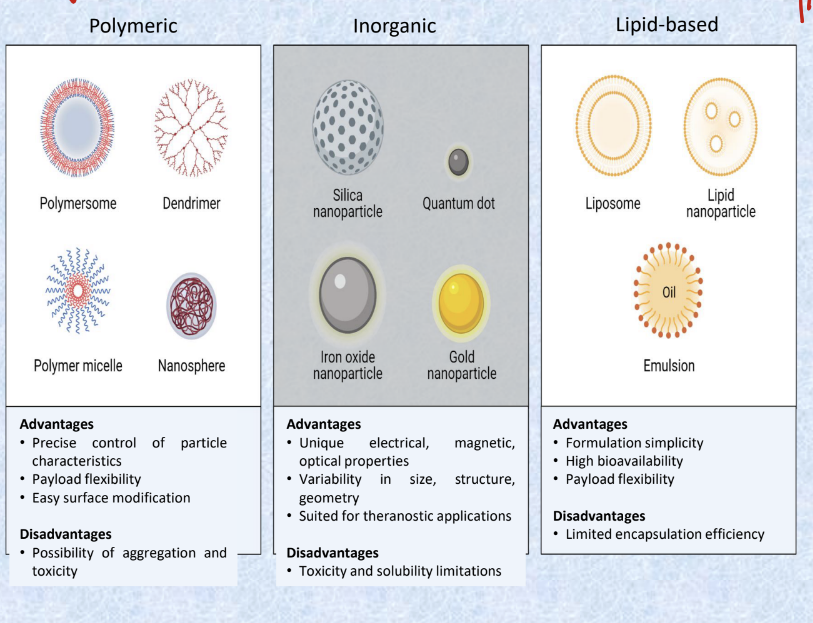
dispersed systems
dispersed systems consist of particulate matter known as dispersed phase distributed throughout a continuous or dispersion medium
dispersed material may range in size from particles of atomic and molecule dimensions to particles whose size is measured in millimeters
dispersed systems are classified based on the mean particle diameter of the dispersed material
3 size classifications
molecular dispersion
size
<1 nm
characteristics of particles
invisible in electron microscope
pass through ultrafilter and semipermeable membrane
undergo rapid diffusion
examples
oxygen molecules
ordinary ions
glucose
colloidal dispersion (IMPORTANT ONE)
size
1 nm - 0.5 micrometers
characteristics of particles
NOT resolved by ordinary microscope (although may be detected under ultra microscope)
visible in electron microscope
pass through filter paper
do NOT pass semipermeable membrane
diffuse very slowly
examples
colloidal silver sols
natural and synthetic polymers
cheese
butter
jelly
paint
milk
shaving cream
nanoparticles
coarse dispersion
size
> 0.5 micrometers
characteristics of particles
visible under microscope
do NOT pass thru normal filter paper
do NOT dialyze thru semipermeable membrane
do NOT diffuse
examples
grains of sand
most pharmaceutical emulsions and suspensions
RBCs
liposomes and drug delivery
liposomes can carry both hydrophobic molecules and hydrophilic molecules
a liposome encapsulates a region on aqueous solution (core) inside a hydrophobic membrane. dissolved into the core, hydrophillic drugs can NOT readily pass thru the lipids
hydrophobic drugs can be dissolved into membrane
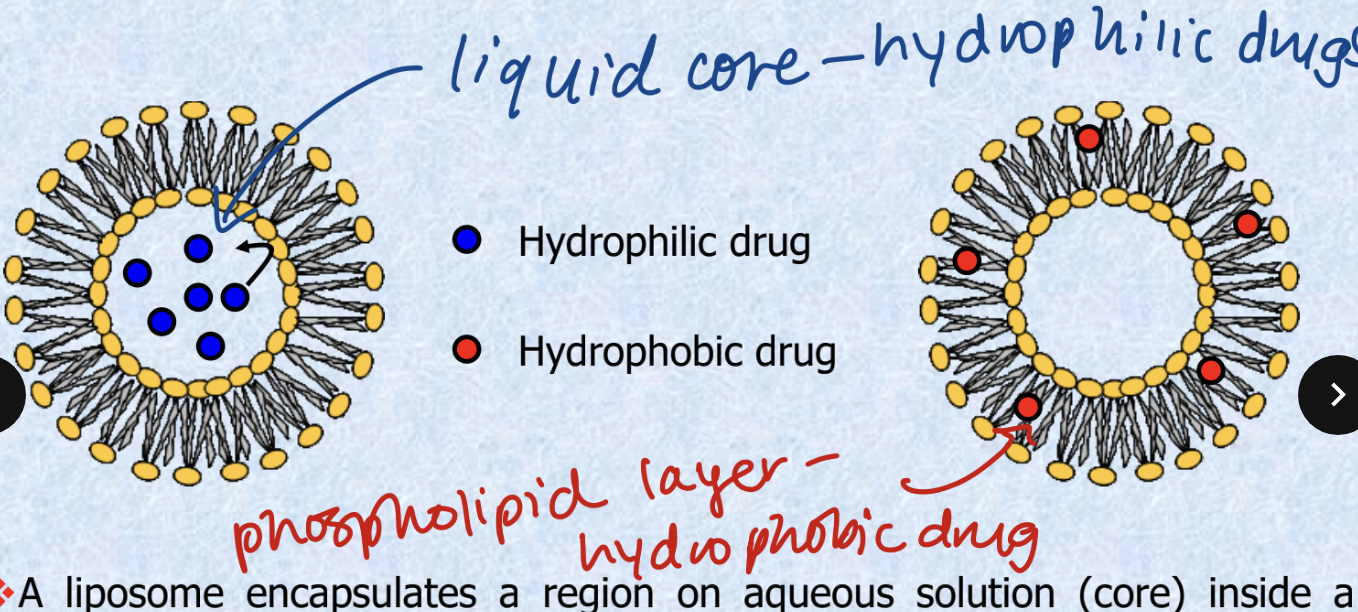
intracellular drug delivery by liposomes: mechanisms of drug release
diffusion
drug inside the carrier diffuses out where there is a change in pH
membrane fusion
carrier fuses directly w/the plasma membrane, releasing the drug contents into the inside of the cell
endocytosis
entire drug loaded carrier is engulfed by the cell thru endocytosis
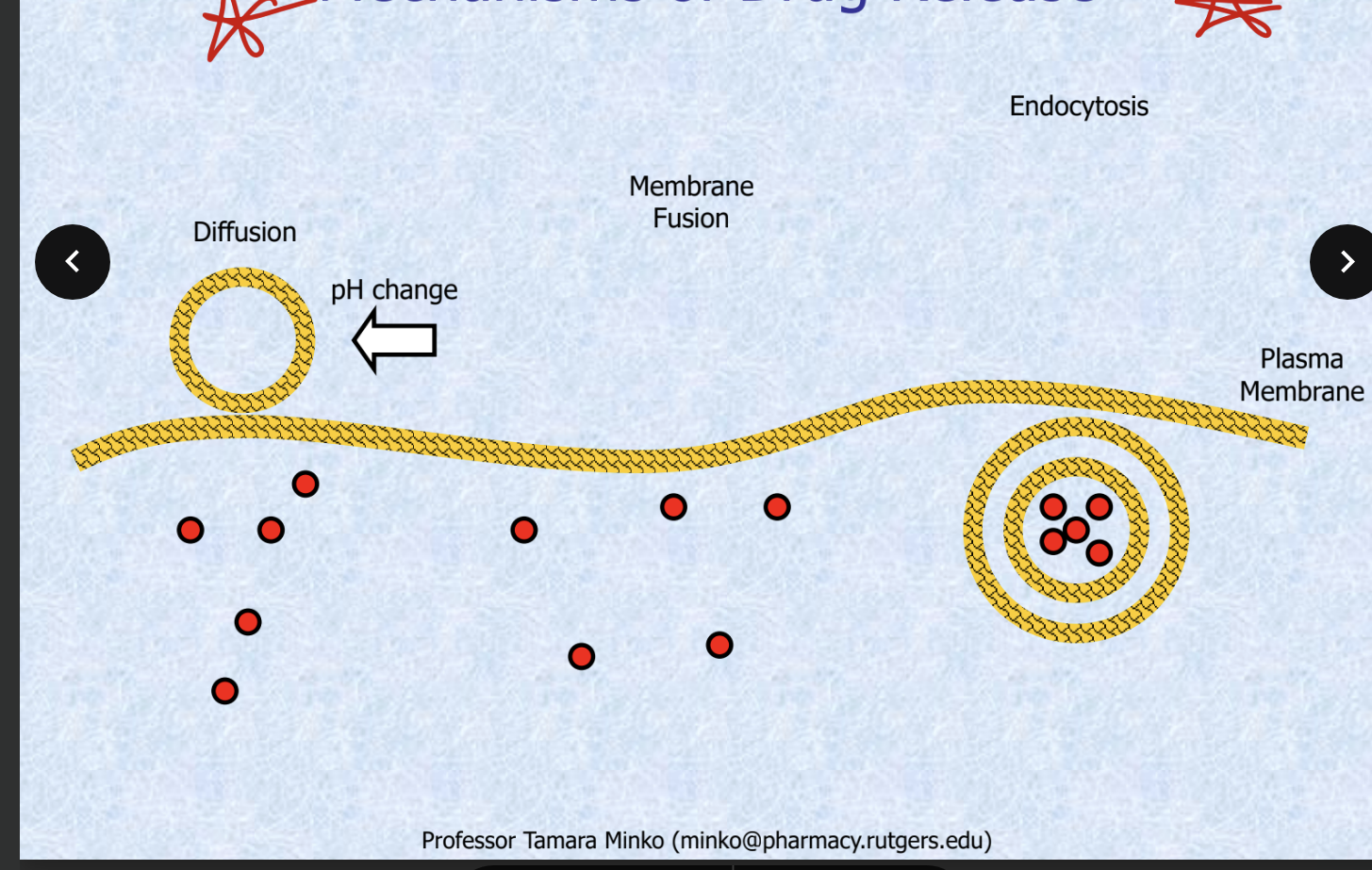
antisense oligonucleotides (ASO) therapy
typical pathway
DNA → transcription → mRNA → translation → protein → function
ASO therapy is focused on the blockade of the synthesis of specific protein by binding to mRNA
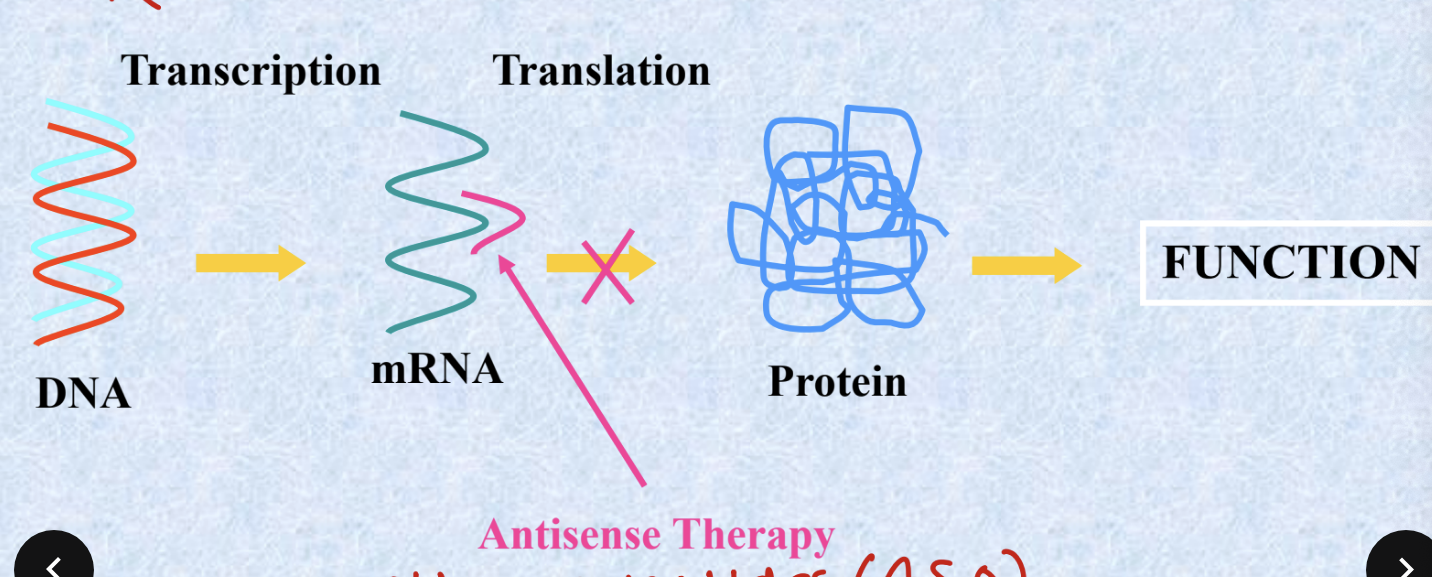
antisense oligonucleotides (ASO)
ASO = single strands of DNA or RNA that are complementary to a chosen sequence
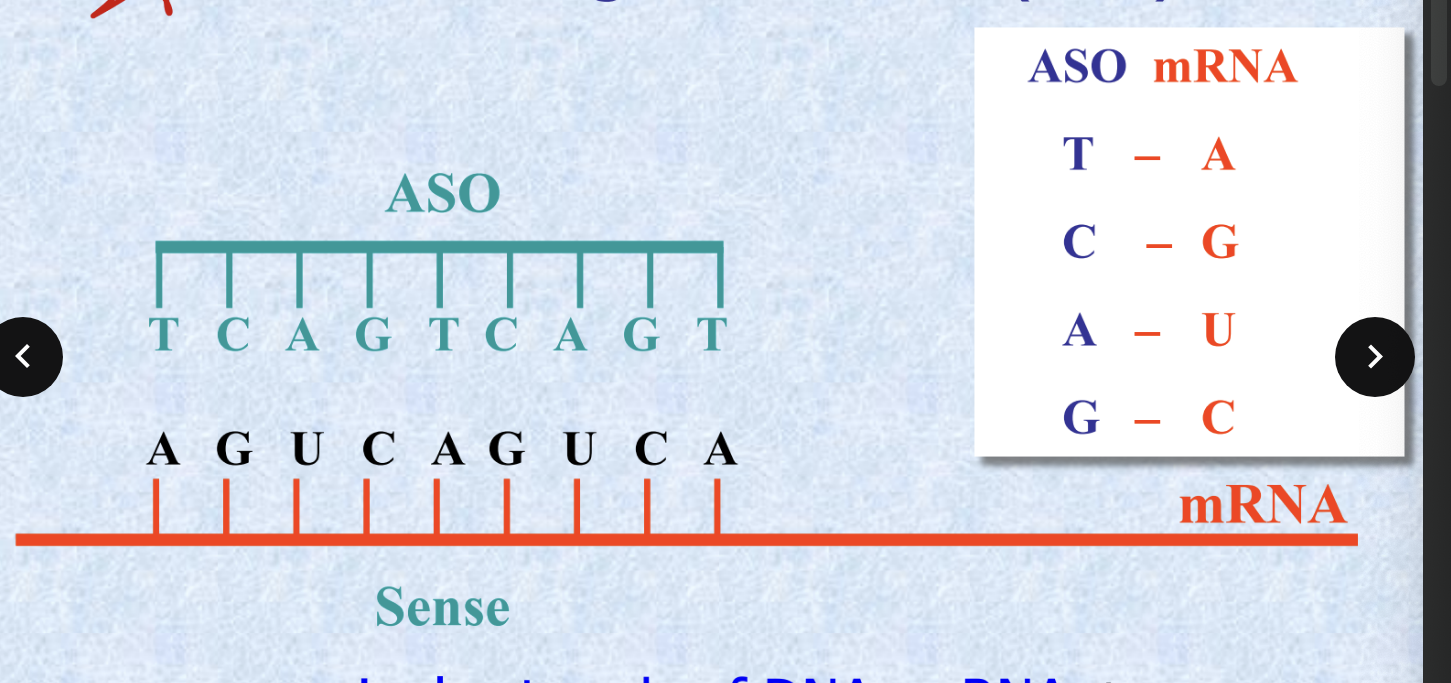
mechanisms of antisense oligonucleotides action
binding of ASO to mRNA forming a duplex and preventing the synthesis of specific protein
enzymatic degradation of mRNA portion of the duplex which releases the ASO for further binding to another mRNA
the release of ASO by the cell into the blood stream and excretion (usually unchanged) by the kidney
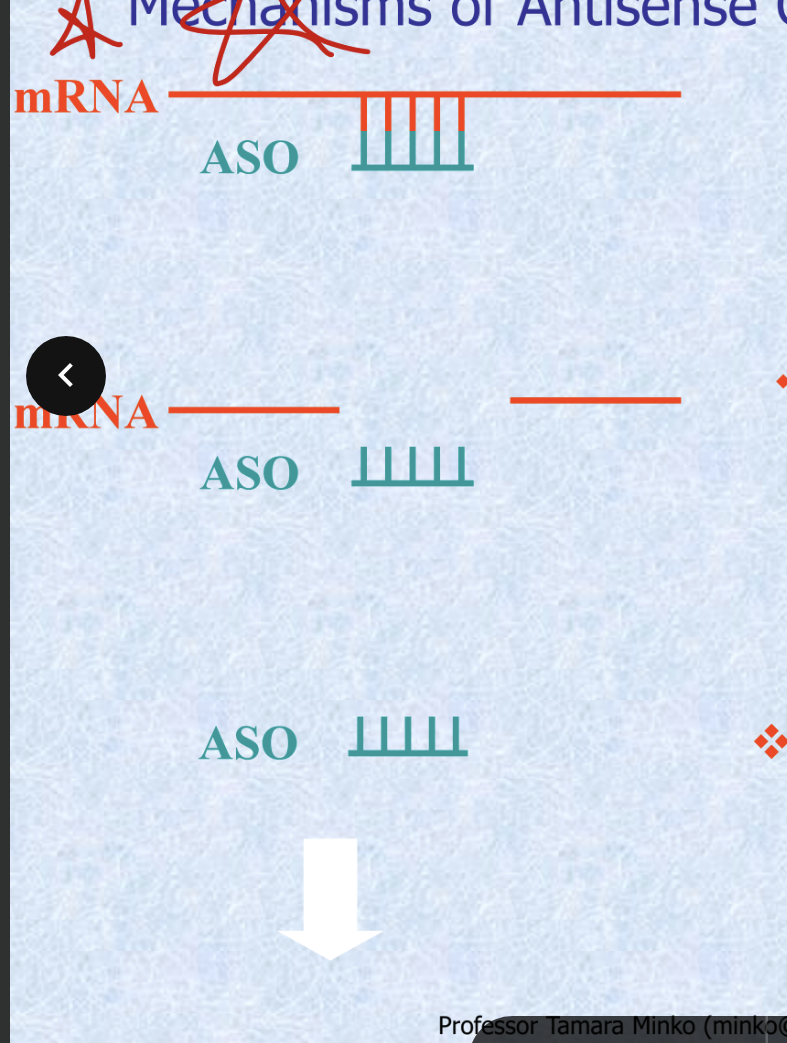
RNA interference (RNAi)
according to recent research, double-stranded RNA molecules (dsRNA) efficiently and specifically inhibits gene products of a post-transcriptional level (gene silencing) → this phenomenon, also called RNAi, has been found in numerous organisms and can be induced artificially
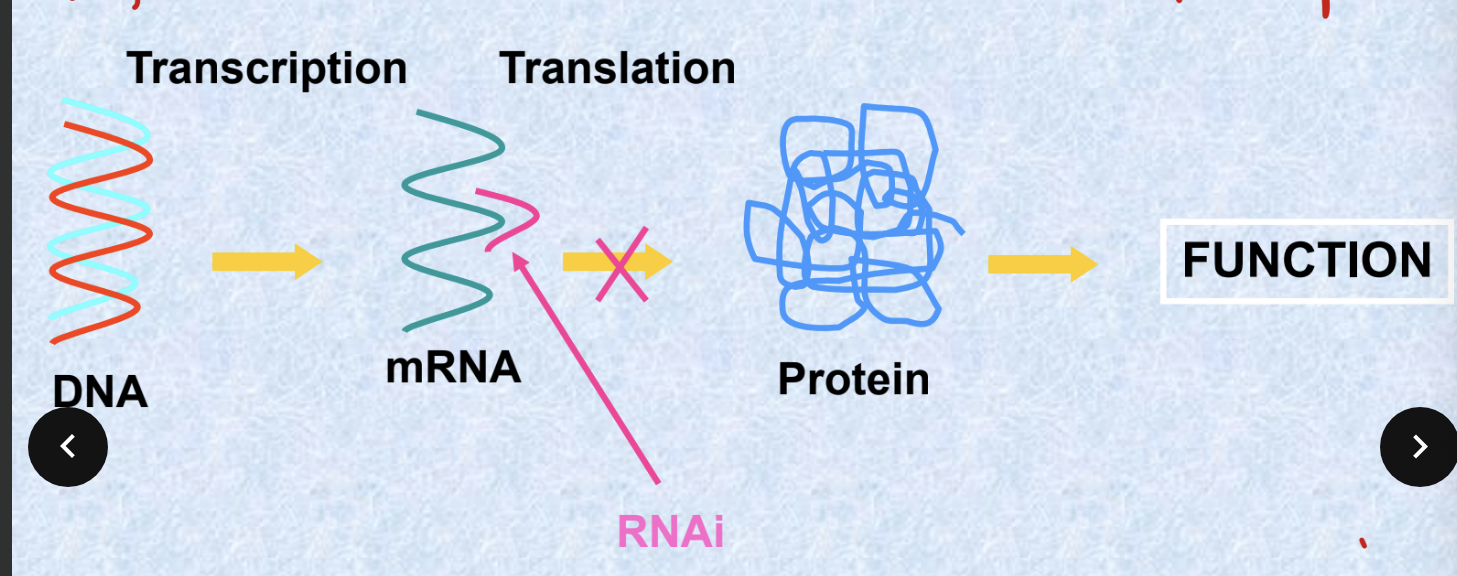
co-suppression
formation of double stranded RNA (dsRNA) can inhibit gene expression in many different organisms
first discovery of this inhibition in plants was more than a decade ago and occurred in petunias; researchers were trying to deepen the purple color of flowers by injecting the gene responsible for the color into petunias but were surprised at the result → instead of darker flower, petunias were either variegated or completely white
phenomenon = co-suppression since both the expression of the existing gene (initial purple color) and the introduced gene (to deepen the purple) were suppressed
co-suppression has since been found in many to inhibit gene expression in other plant species and in fungi; double stranded RNA responsible for this effect
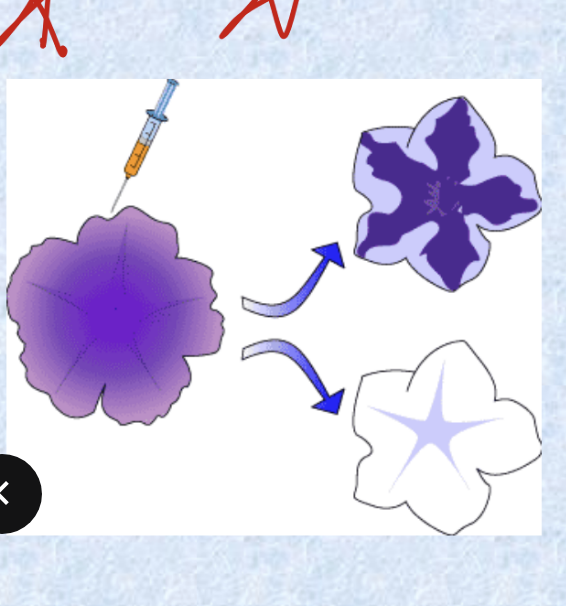
RNA interference and small interfering RNA (siRNA)
since the only RNA found in a cell should be single stranded, presence of double stranded RNA signals = abnormality
cell has specific enzyme (in drosophilia it is called dicer) that recongnizes the double stranded RNA and chops it up into small fragments between 21-25 BPs in length → these short RNA fragments (siRNA) bind to RNA-inducing silencing complex (RISC) → RISC is activated when the siRNA unwinds and the activated complex binds to the corresponding mRNA using antisense RNA → RISC contains an enzyme to cleave the bound mRNA (called slicer in drosophilia) → cause gene suppression → once mRNA has been cleaved it can NO longer be translated into functional protein
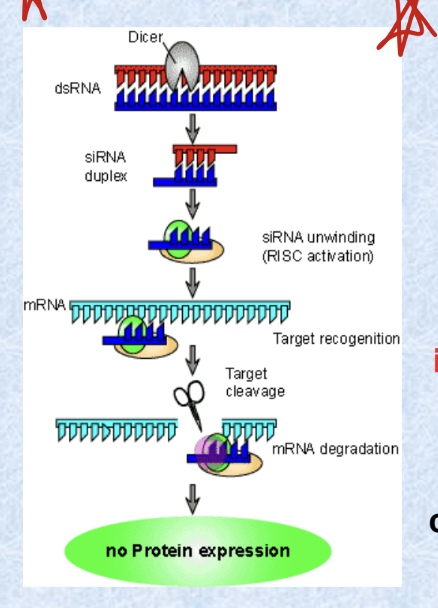
advantages of antisense/siRNA therapy
extremely high specificity
selective knockout of single critical target
potential for increased efficacy
reduced likelihood of side effects
small interfering RNA (siRNA) therapy: challenges
low stability → siRNA backbone is susceptible to hydrolysis by serum nucleases in extracellular environment
integrity of chemically stabilized siRNA is maintained in blood for at least 30 minutes whereas unmodified (naked) siRNA duplex is degraded within 1 minute
rapid elimination → the small size of siRNA leads to the rapid elimination of naked, unmodified siRNAs from the circulation by renal clearance (circulatory half-life of siRNA < 5 mins)
poor cellular internalization → delivery of siRNA across the cell membrane into the cells is limited by the repulsion of the negatively charged siRNA by the like-charged cell membrane
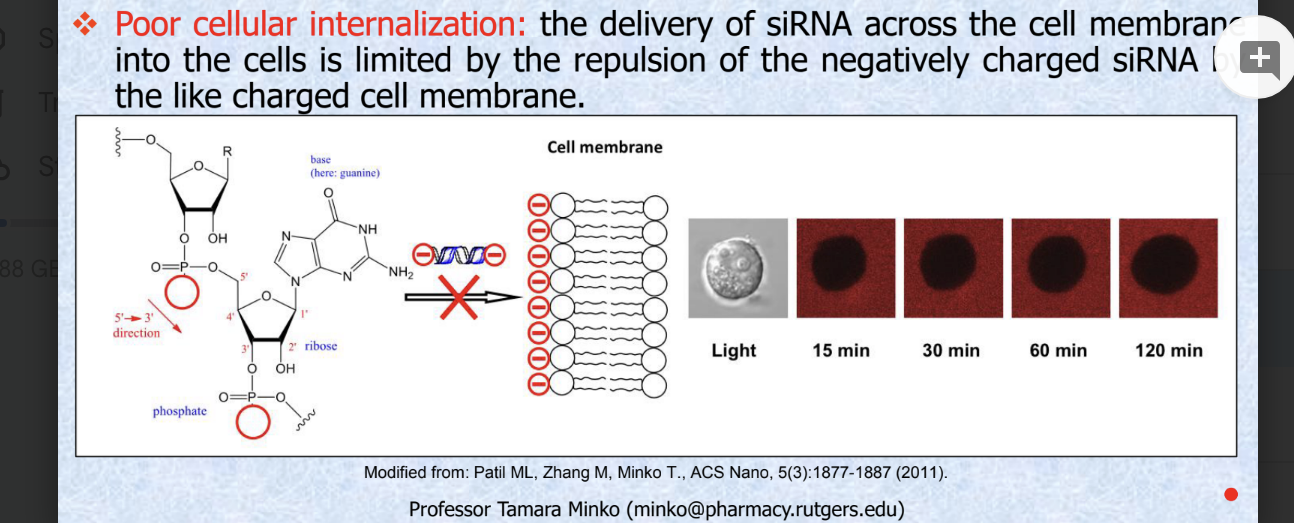
branched polymer: dendrimers
dendrimer = regularly branched molecule which resembles the branches of a tree
properties of dendrimers are dominated by the functional groups on the molecular surface:
can be water soluble when its end group is a hydrophilic group like carboxyl group
theoretically possible to design a water-soluble dendrimer with internal hydrophobicity which would allow it to carry a hydrophobic drug in its interior
volume of a dendrimer increases when it has a positive charge
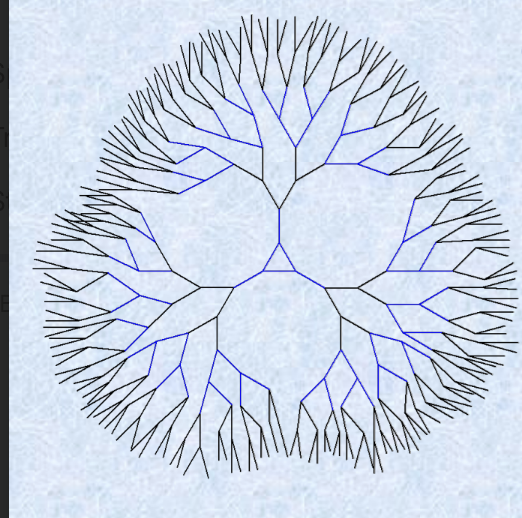
polyamidoamine (PAMAM) dendrimers
greater the generation → greater molecular weight → greater diameter → greater surface groups
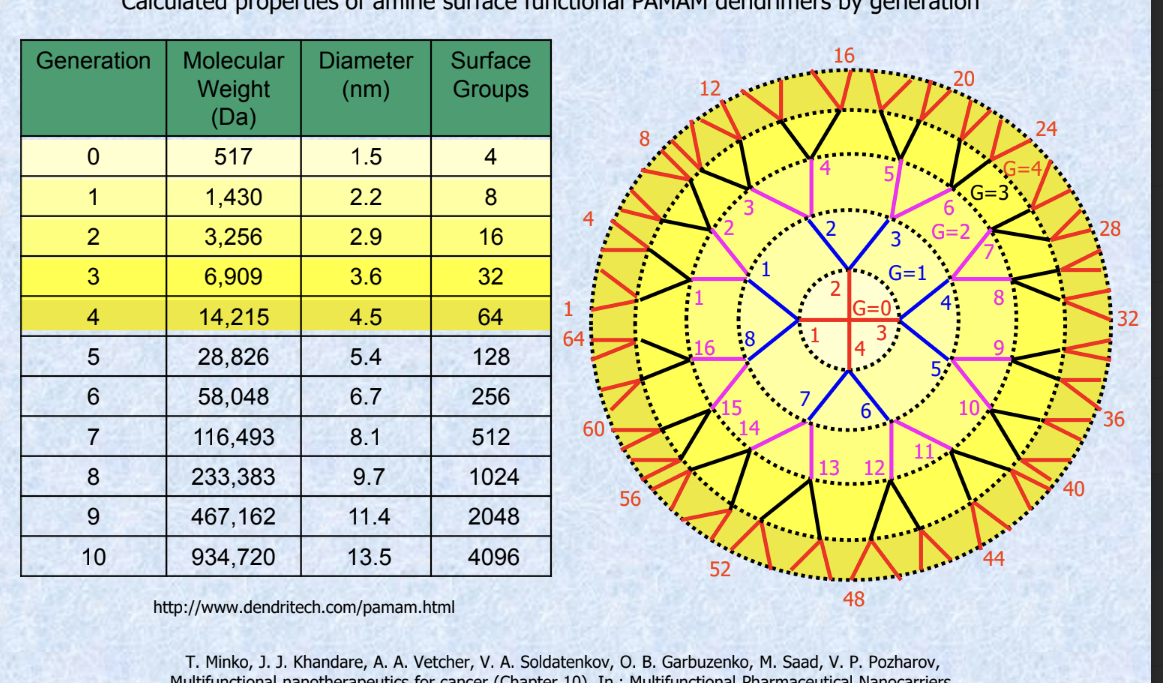
surface modified and internally cationic PAMAM dendrimers for efficient siRNA intracellular delivery
traditional dendrimers
non-modified surface; external positive chargers for siRNA binding
nano-fiber shaped structures (will ask about this)
modified dendrimers
acetylated surface; internal positive charges for siRNA binding
chemical modification of surface moves the + charge inside dendrimer
well-condensed spheroidal nanoparticles (will ask about this)
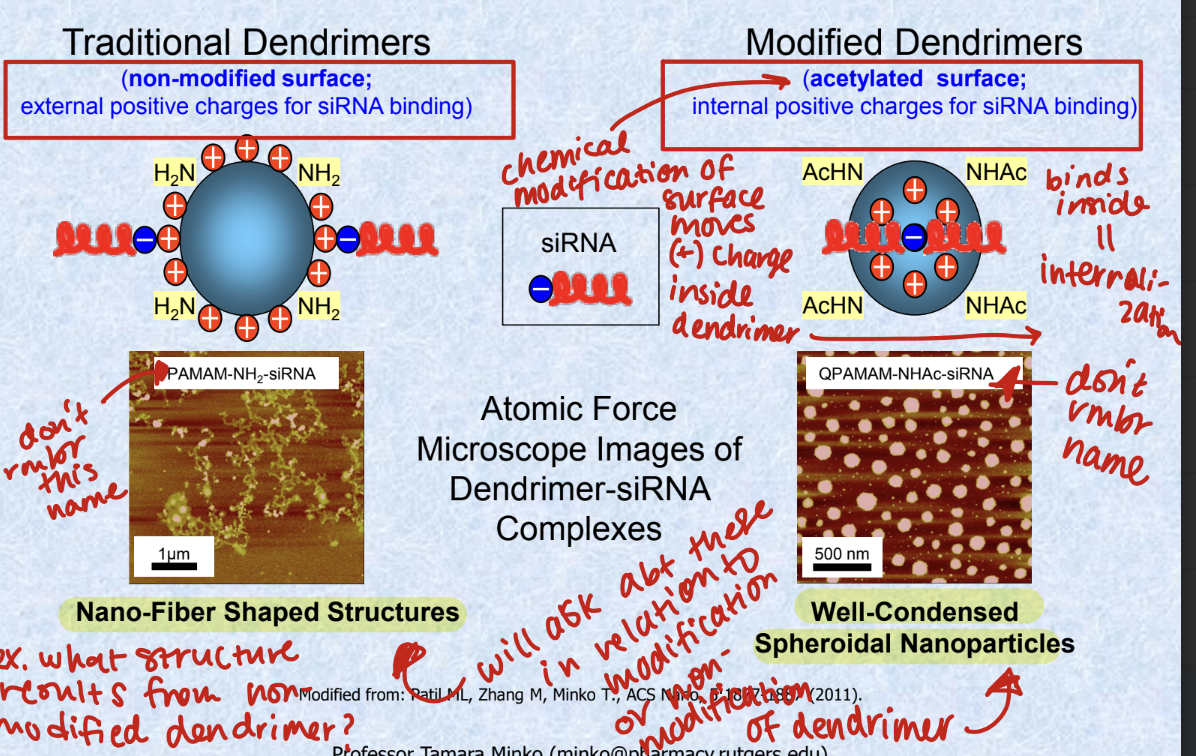
surface modified and internally cationic PAMAM dendrimers
QPAMAM-NHAc is a generation 4 dendrimer which is acetylated neutral surface
has greater cellular variability
reduced cyto- and genotoxicity
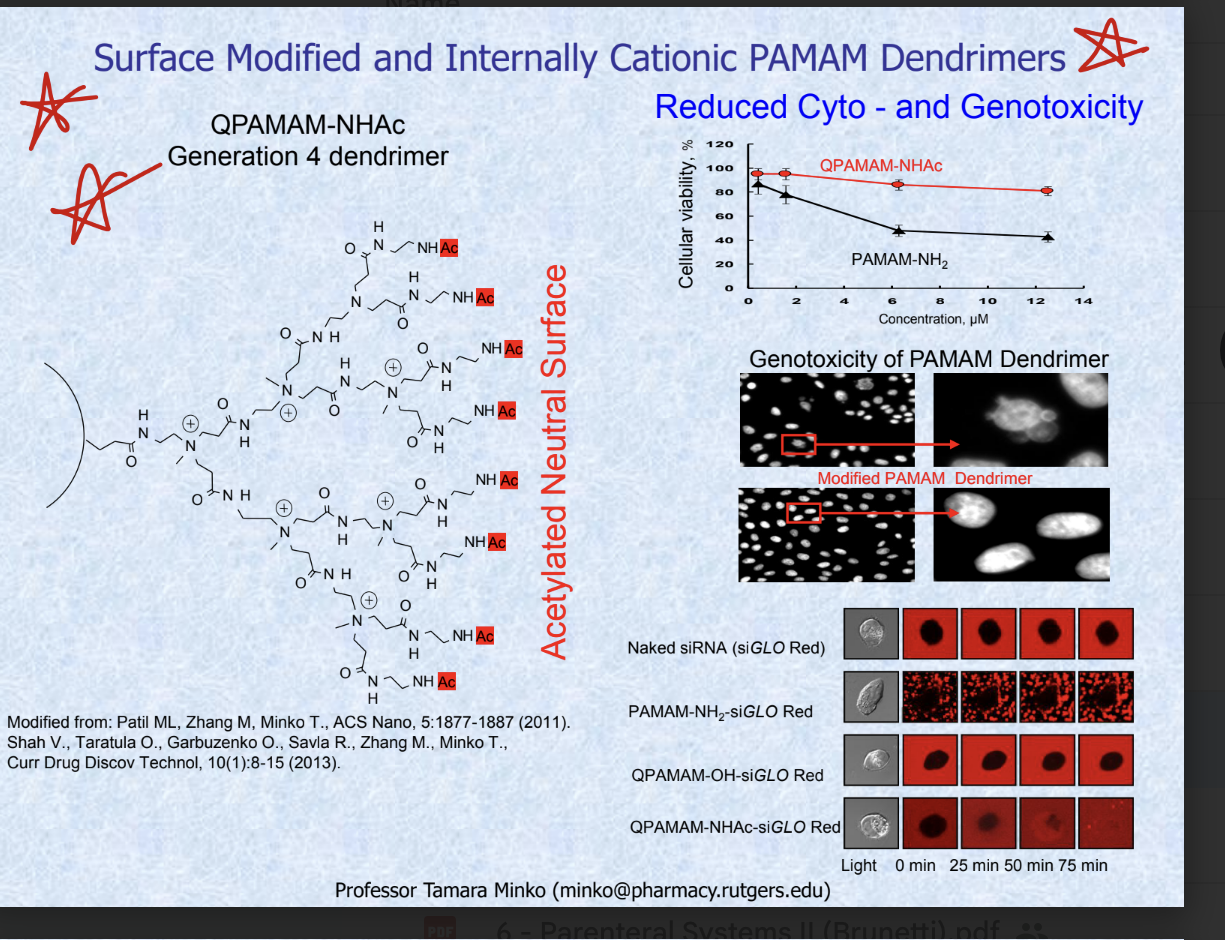
quantum dots (QD)
quantum dots (QD) are very small semiconductor particles, only several nanometers in size, so small that their optical and electronic properties differ from thse of larger particles
many types of QD will emit light of specific frequencies if electricity or light is applied to them and these frequencies can be precisely tuned by changing the dots’ size, shape and material, giving rise to many applications
colloidal quantum dots irradiated with UV light; different sized quantum dots emit different color light due to quantum confinement
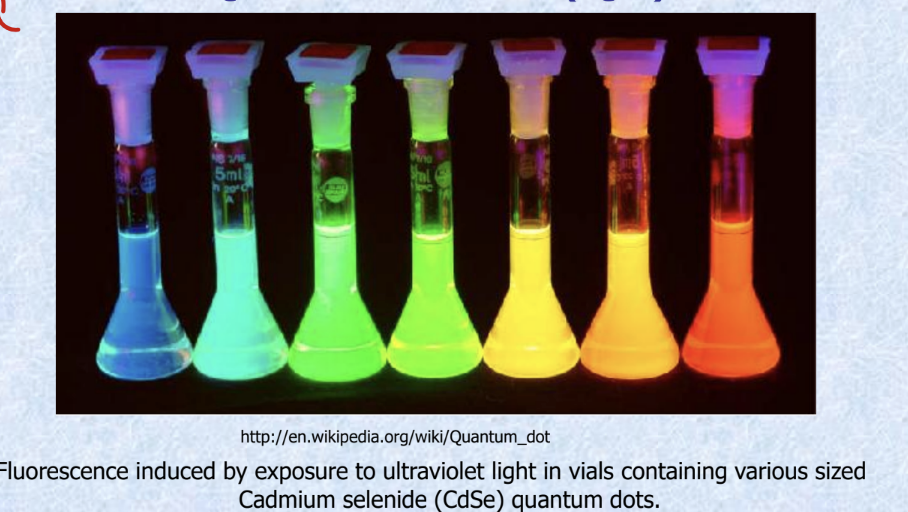
quantum dots nanocrystals
structure of colloidal quantum dots nanocrystal
15-20 nm wide
from inside to outside
core (quantum dot) → shell → polymer coating → biomolecule (antibody, etc)
tuneability of colloidal quantum dots nanocrystals
5 different nanocrystal solutions are shown excited with the same long-wavelength UV length → size of nanocrystal determines the color
largest to smallest: red → orange → yellow → green → blue
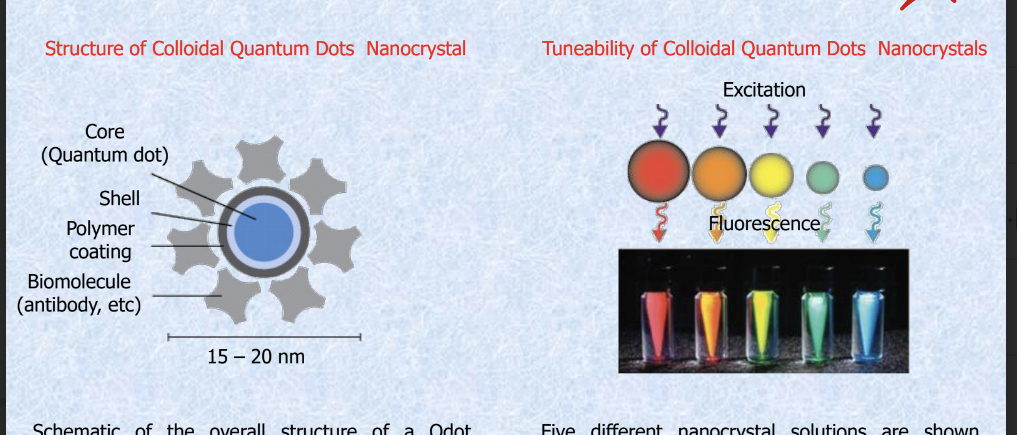
superparamagnetic iron oxide (SPIO) nanoparticles
SPIO nanoparticles have been used extensively as contrast agents for MRIs
SPIO nanoparticles should also allow the targeting of attached vectors to desired locations by the application of magnetic fields
SPIO nanoparticles have shown promise as miniaturized heaters capable of killing cancer cells
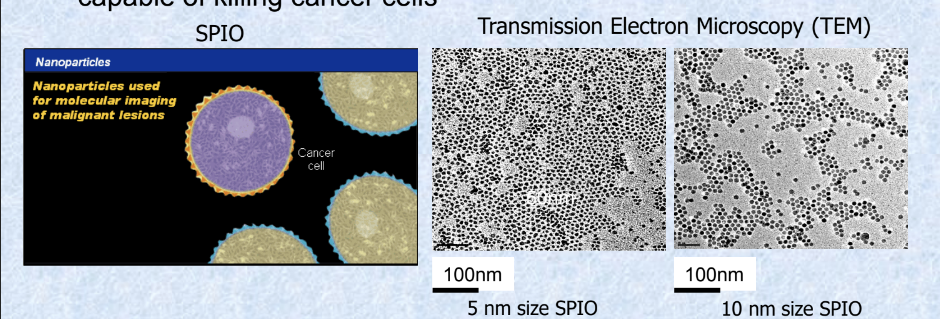
expression of CD44 protein in ascitic cells obtained from pts with metastatic ovarian carcinoma
CD44 antigen, cell-surface glycoprotein involved in cell-cell interactions, cell adhesion and migration = one of the major cell surface markers for cancer stem cells
cancer stem cells/cancer initiating cells = with the CD44 marker
regular cancer cells do NOT have the marker
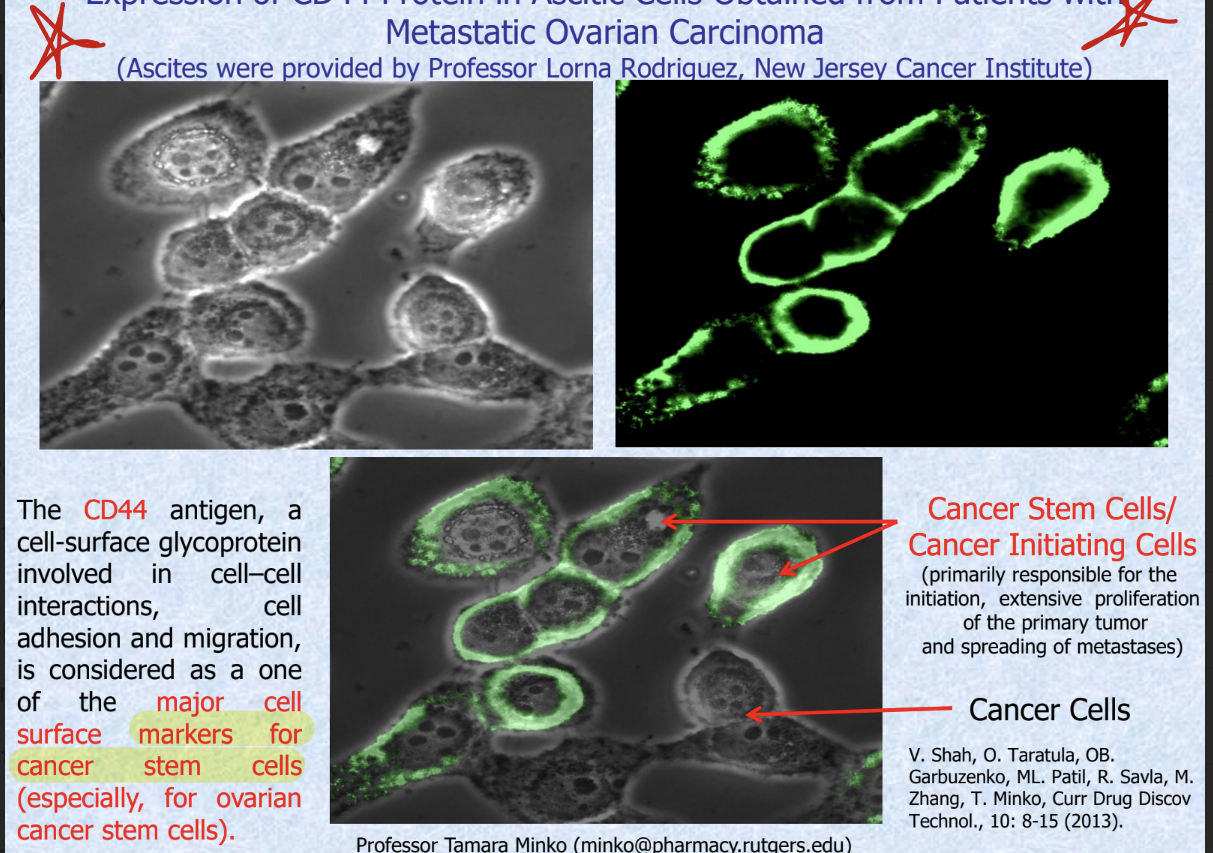
cancer stem cells
cancer stem cells are the seeds of cells; primarily responsible for the initiation, extensive proliferation of the primary tumor and spreading of metastases
stem cell characteristics
self-renewal
extensive cell proliferation
capability to initiate tumor growth and metastases
CD44 antigen, a cell surface glycoprotein involved in cell-cell interactions, cell adhesion and migration is considered as one of the major cell surface markers for cancer stem cells (esp ovarian cancer stem cells)
cancer stem cells: the seeds of metastases
important feature of cancer stem cells = ability to initiate tumor grows and metastases
as few as 200 cancer cells displaying CD44+ phenotype form tumors in immunodeficient mice whereas 20,000 cancer that do NOT display this marker FAIL to form tumors
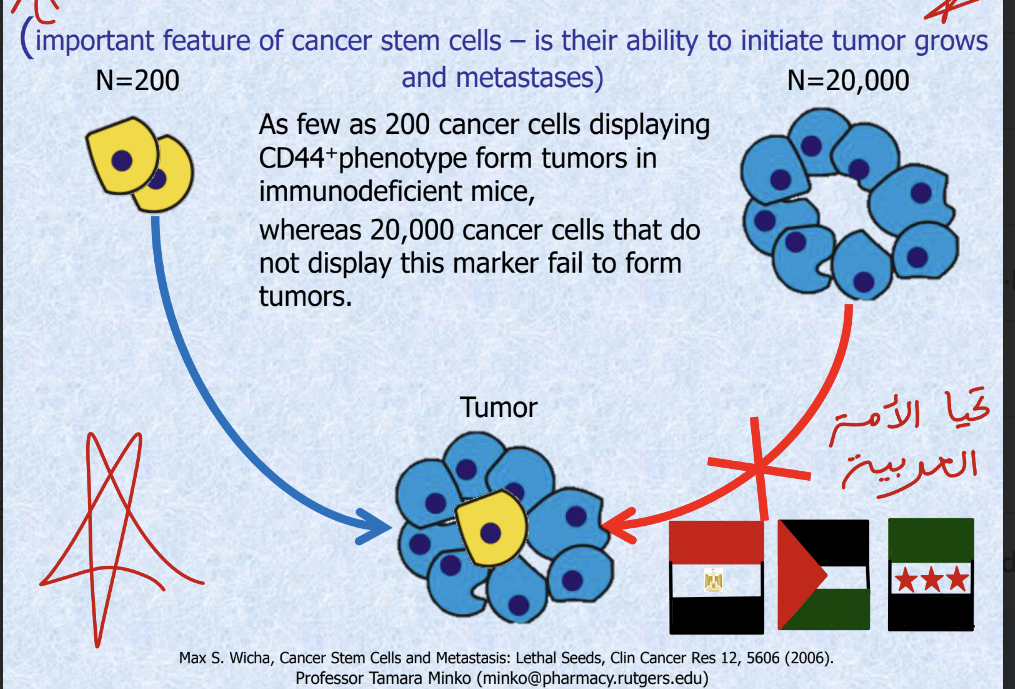
distribution of non-targeted and LHRH-receptor-targeted dendrimers in mice bearing xenografts of human ovarian carcinoma
tumor cells over-expresses LHRH receptors → attaching a LHRH peptide to the dendrimer specifically guides it to the tumor
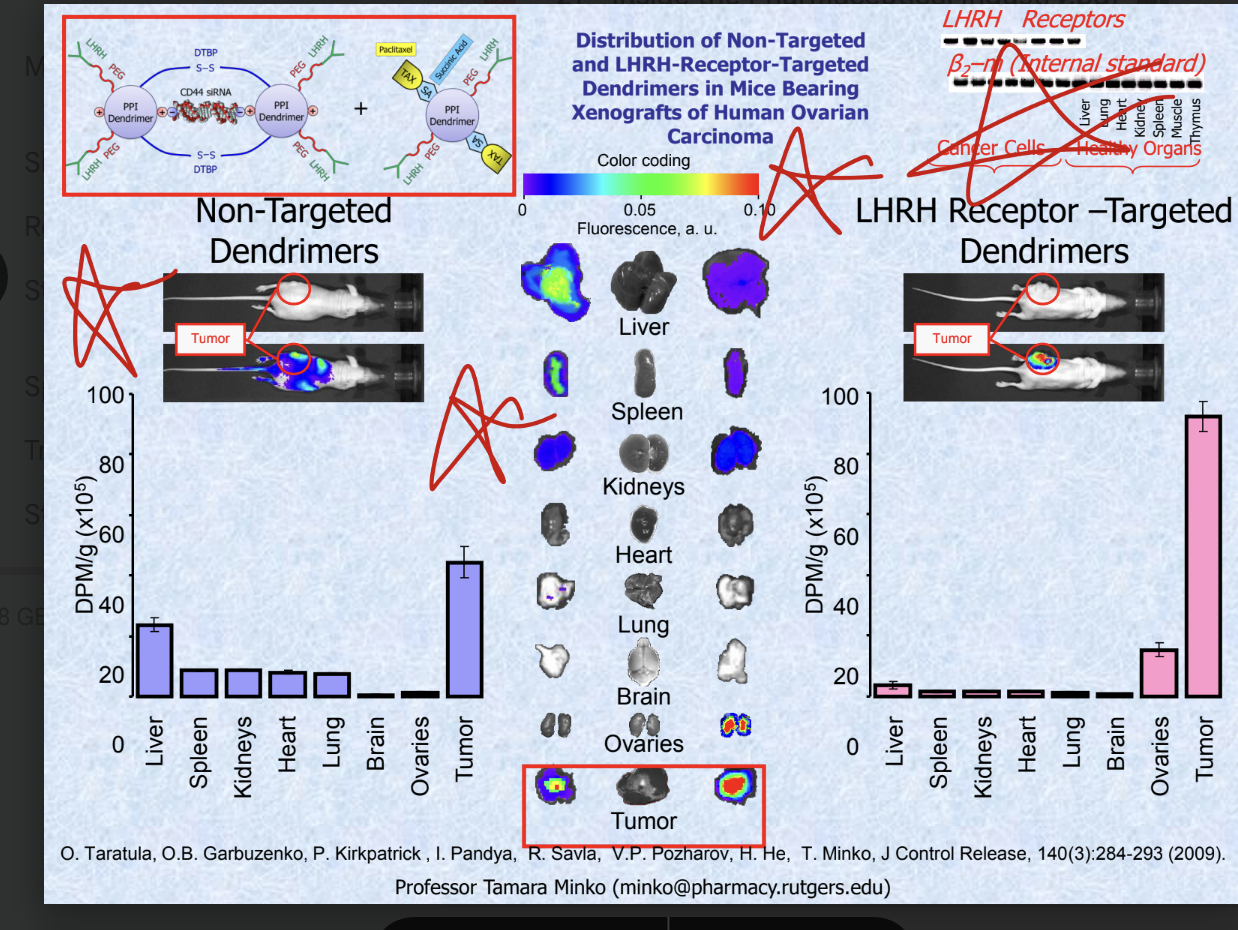
apoptosis induction and tumor size
apoptosis and tumor volume in mice bearing xenografts of human cancer cells isolated from malignant ascites from pts with advanced ovarian carcinoma
mice were treated 8 times 2x per week within 4 weeks starting from day 0 with indicated formulations
WILL ASK ABOUT THIS
suppression of CD44 protein in cancer cells enhances anti-tumor effect of anticancer drug → limits tumor growth and prevents adverse side effects of chemotherapy
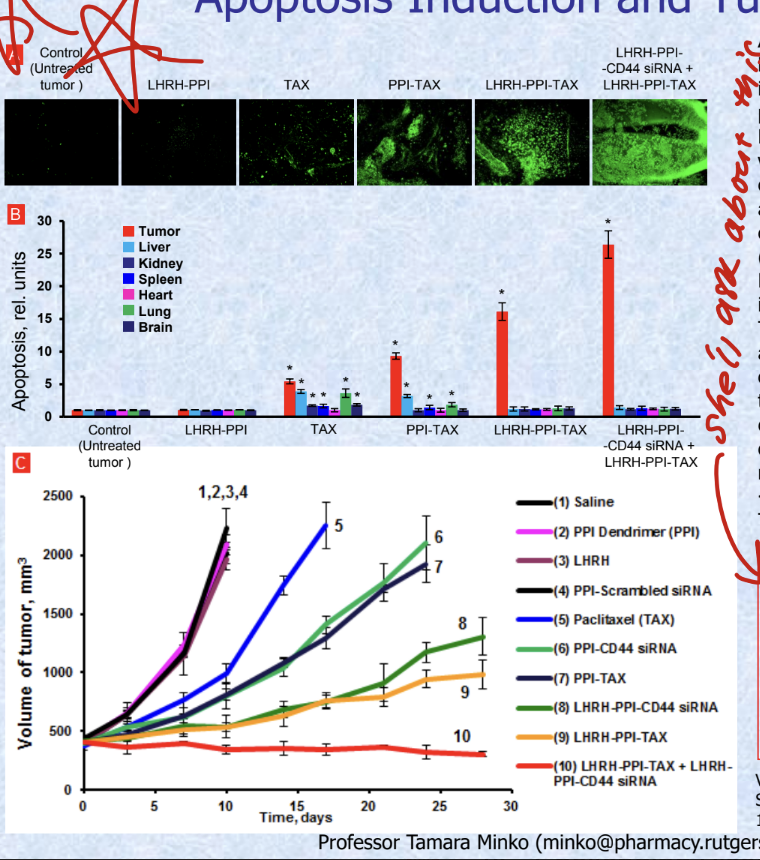
intracellular accumulation of doxorubicin
drug sensitive cells (DOX)
85% of drug stays inside the cell
15% in medium
drug resistant cells (DOX)
83% of drug in medium
17% in cells
drug resistance cells (lip-DOX-MDR1 ASO)
69% in cells
31% in medium
suppression of P-glycoprotein increases drug accumulation inside cancer cells and suppresses drug resistance
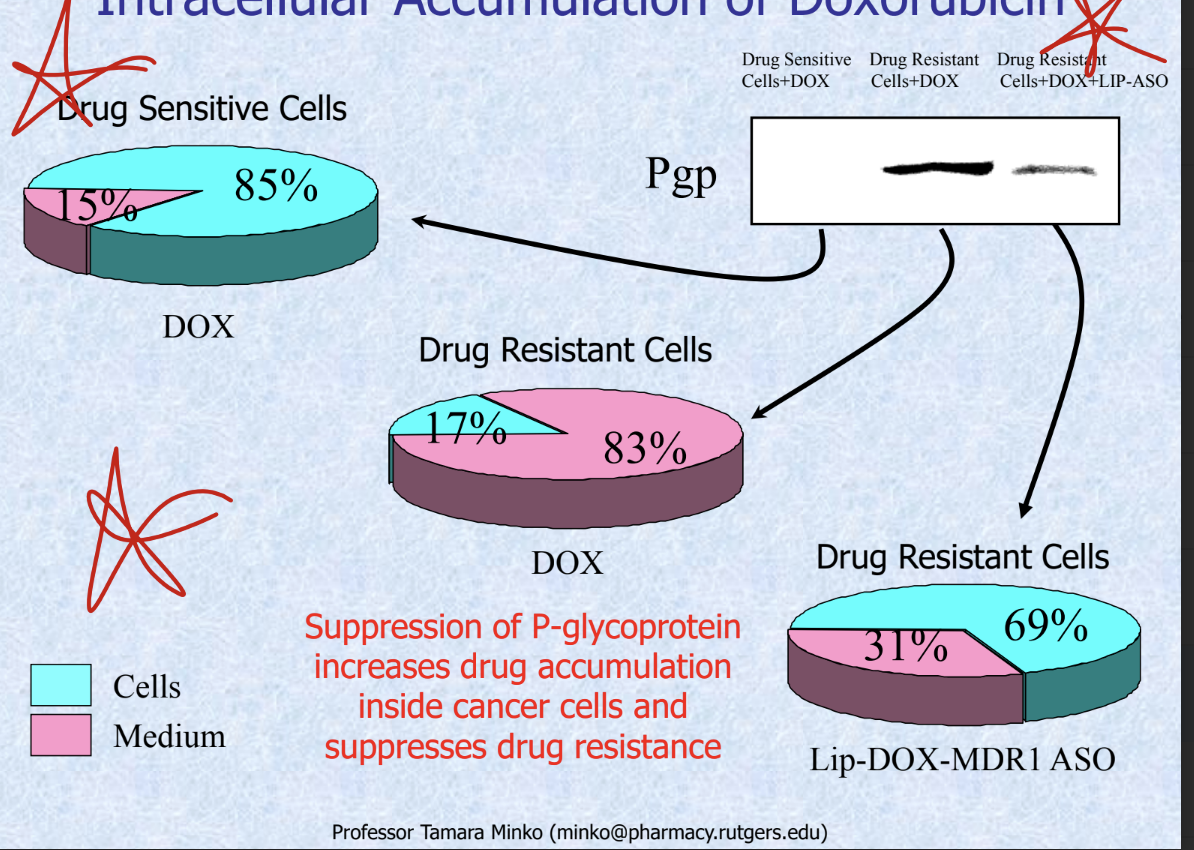
personalized medicine
often called the right treatment for the right pt and the right time
can be used to learn about a person’s genetic makeup and to unravel the biology of their tumor; using this info to identify prevention, screening and treatment strategies that may be more effective and cause fewer side effects than would be expected with standard treatments
plan of attack
analyze pt’s individual profile
anticipate pt reaction to certain drugs
overcome potential complications or adverse side effects
challenges of drug delivery for treatment of lung diseases
limitations of systemic lung delivery
enzymatic degradation in the GI tract and liver
short half life and degradation of drugs in blood stream
low accumulation and retention of drugs in lungs
low efficacy of treatment
possible adverse side effects on other organs
advantages of local inhalation drug delivery directly to the lugs
enhanced accumulation and retention of drugs in the lungs
prevention (or at least limitation) of penetration of drugs into the bloodstream and accumulation in other healthy organs
high efficacy of treatment
challenge
majority of free drugs, native nucleic acids, and peptides CANNOT be delivered into the lungs by inhalation necessitating a special dosage form or delivery system that can be inhaled

nanotechnology based approach for treatment and imaging
nanostructure lipid carriers (NLC)
carry drug and siRNA attached by disulfide bonds
targeting agents are attached to guide the carriers → tumors
PEG is used to stabilize the particles and prevent aggregation
cationic liposomes
positively charged liposome with siRNA molecules attached
positive charge helps bind and deliver siRNA into negatively charged cell membranes
neutral PEGylated liposomes
liposomes made neutral with PEGylation
carriers multiple things
CIS and DOX = chemotherapy drugs
MDR1 ASO = antisense oligonucleotide to block drug resistance gene
BCL2 ASO = antisense to block anti-apoptosis gene
drugs
anticancer
anti=inflammatory
antioxidant
nucleic acids
siRNA or ASO
targeted proteins are selected from the following classes
plasminogen and plasminogen activator
matrix metalloproteases
angiotensinogen
members of TGF-beta signaling pathways
chemokines
gamma interferon
interleukins and their receptors
tumor necrosis factor and its ligand
integrin
transforming growth factor
hypoxia inducible factors
proteins responsible for drug resistance
targeting agent
LHRH for cancer
DSPE-PEG-poly(ethylene glycol)
molecules were introduced to NLC in order to stabilize them against aggregation
DOTAP
NLC were prepared through the incorporation of DOTAP into nanoparticle structure
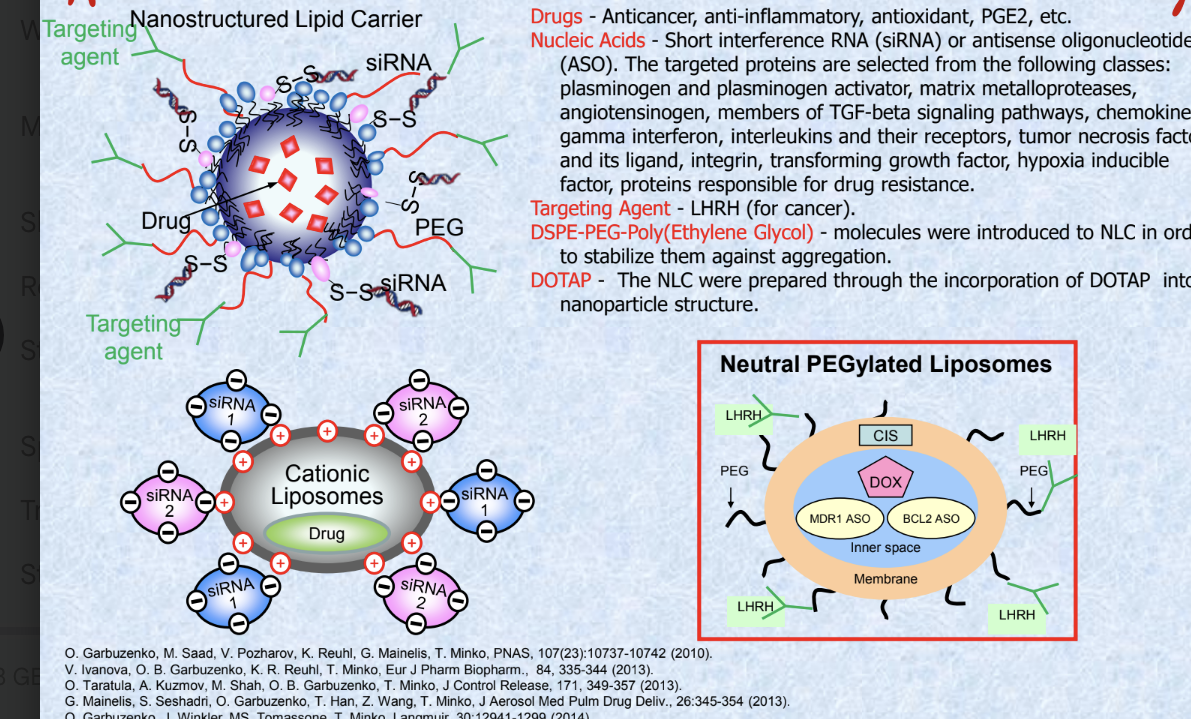
organ distribution and retention of lipid nanoparticle after IV or inhalation delivery
organ distribution of NLC
IV injection
52% liver
24% lungs
inhalation
75% lungs
15% liver
inhalation delivery of lipid nanoparticles leads to their preferential accumulation in the kungs
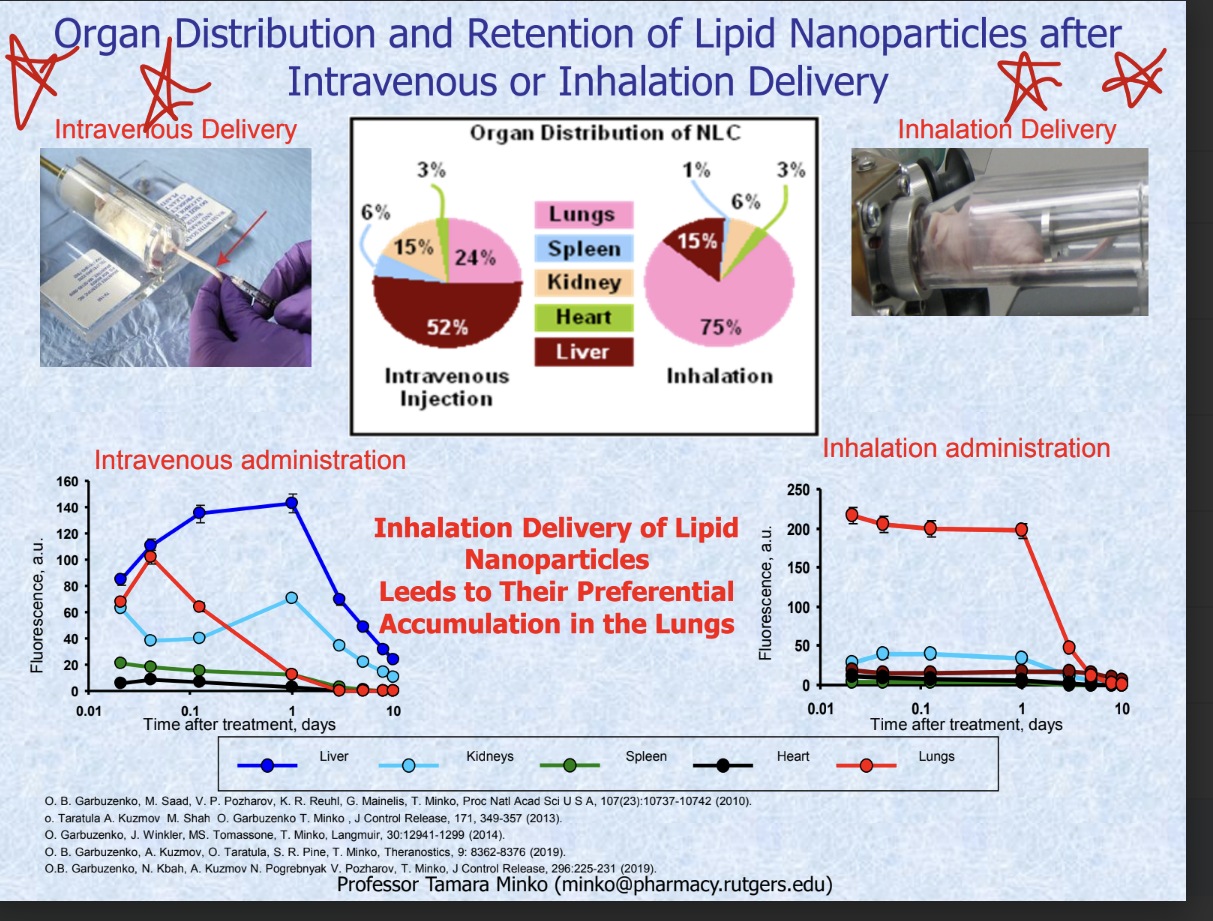
different types of vaccine
type of vaccine = virus-like particle
licensed vaccines using this tech = HPV
first introduced = 1986 (hep B)
type of vaccine = nucleic acid vaccine
licensed vaccines using this tech = SARS-CoV-2
first introduced = 2020 (SARS-CoV-2)
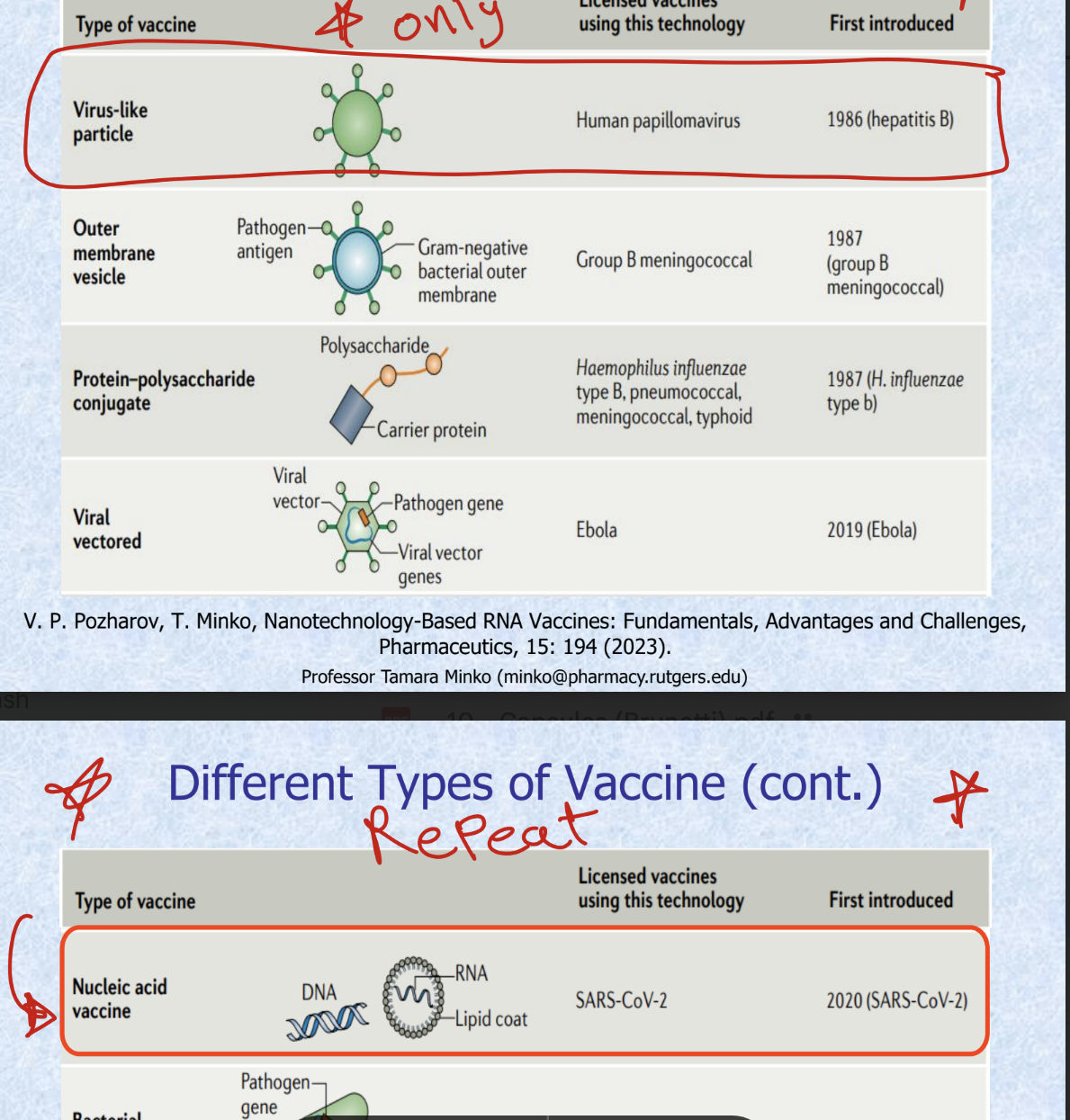
human coronavirus
spike proteins found on the outside of virus
genome contains single stranded positive-sense RNA encapsulated within a membrane with avg diameter of 75-150 nm
envelope is covered with glycoprotein spikes giving covid their crown-like appearance
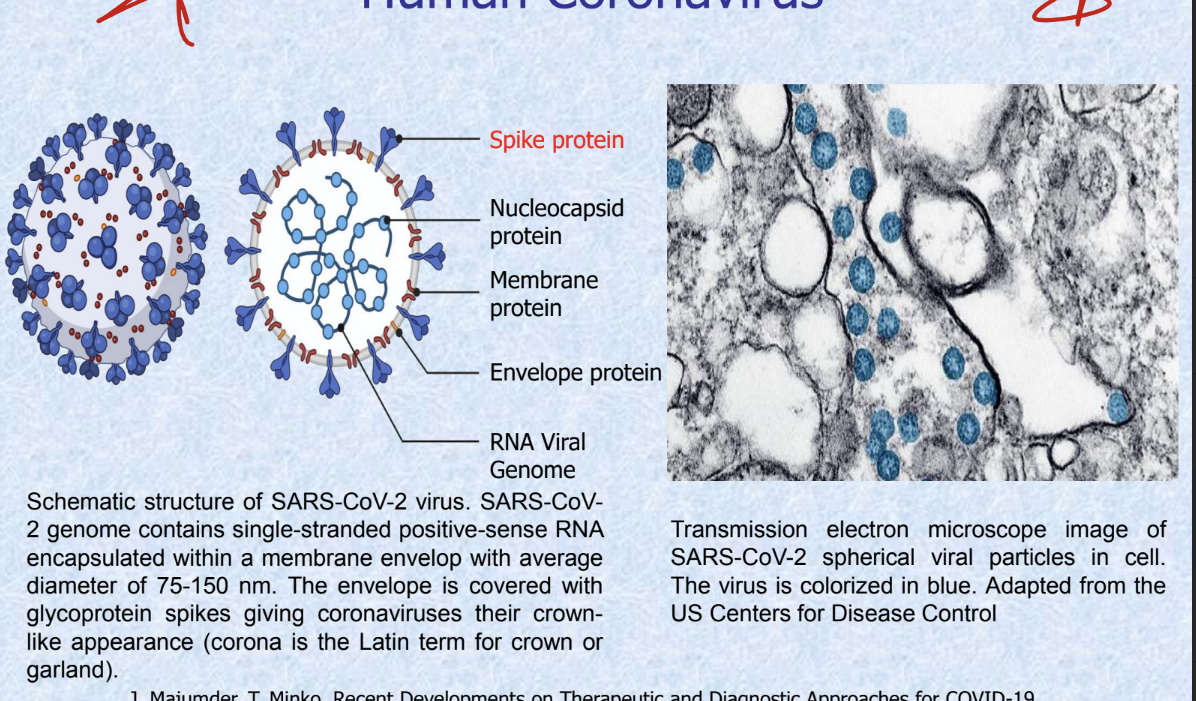
corona virus replication
replication of COVID-19 requires a host cell and normally includes attachment, penetration, uncoating, replication, assembly and release steps
spice glycoprotein on the surface of COVID-19 binds to angiotensin-converting enzyme 2 (ACE2) receptor protein located on the host cell plasma membrane and facilitates the host cell invasion
KNOW HOW COVID GETS INTO CELL
binding and viral entry via receptor mediated endocytosis
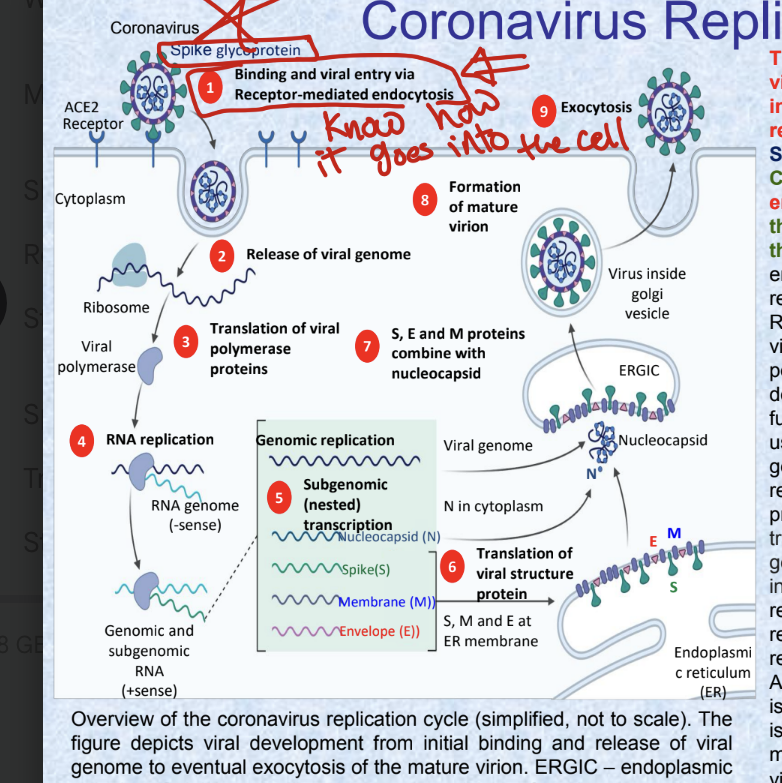
proposed therapeutic treatments
2 distinct approaches are being explored for repurposing of conventional drugs and development of novel therapeutic drugs
prevention of virus entry into host cells
target ACE2 receptors and make it so that the virus CANNOT bind and infection is prevented
target RBD of spike protein → make things bind to the covid spikes so it can’t bind to ACE2 receptors
suppression of various steps in virus replication inside the cells
shit ton of things you can use to block steps
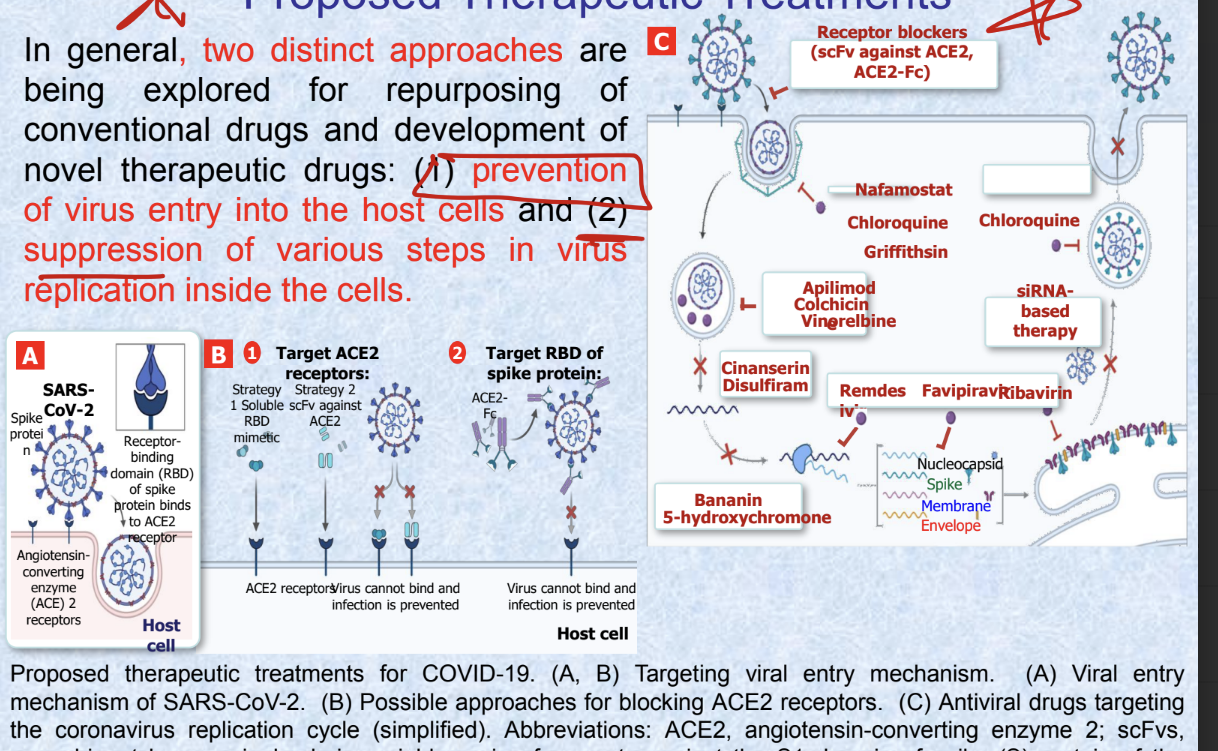
2 major types of COVID-19 vaccine
mRNA encoding the SARS-CoV spike (S) protein encapsulated in lipid nanoparticles
contains mRNA instructions for making the S protein of the virus → mRNA is protected inside lipid nanoparticles → once inside your body, cells use mRNA to make S protein
adenovirus (AdV) vectors encoding the S protein
use harmless virus (adenovirus) that carriers DNA instructions for S protein → adenovirus delivers DNA into your cells which then makes the S protein
both gain entry into dendritic cells at the injection site resulting in production of high levels of S protein
how immune system responds
dendritic cells pick up the S protein → dendritic cells release inflammatory molecules to signal danger → dendritic cells show the S protein to T cells which activate and either kill infected cells or help other immune cells → helper T cells activate B cells which turn into plasma cells that make antibodies against S protein
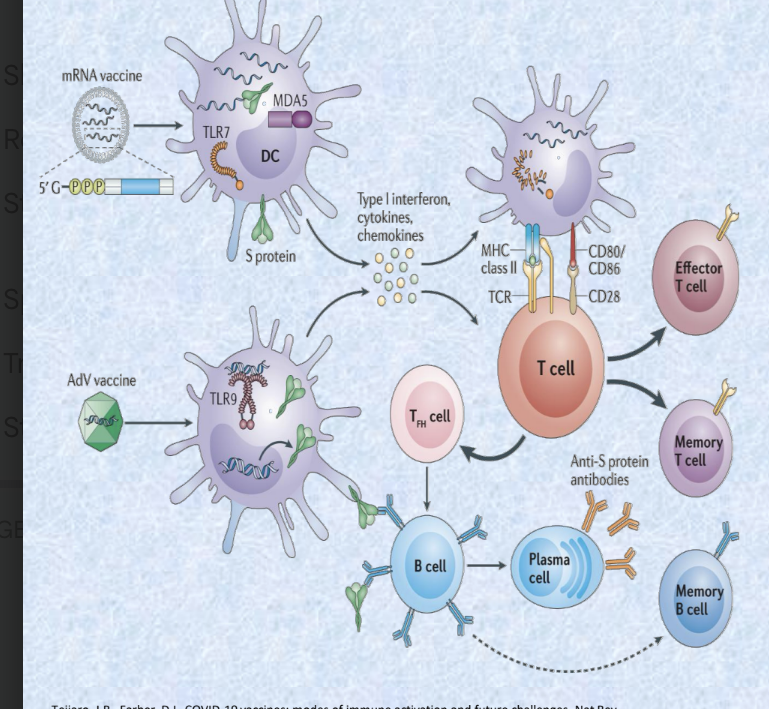
mRNA based COVID vaccines
platform = lipid nanoparticle-encapsulated mRNA encoding COVID-19 S protein
lipid nanoparticles (LPNs) are prepared through rapid mixing, often facilitated by microfluidic devices
LPNs are formed through a cascade of merging smaller lipid vesicles
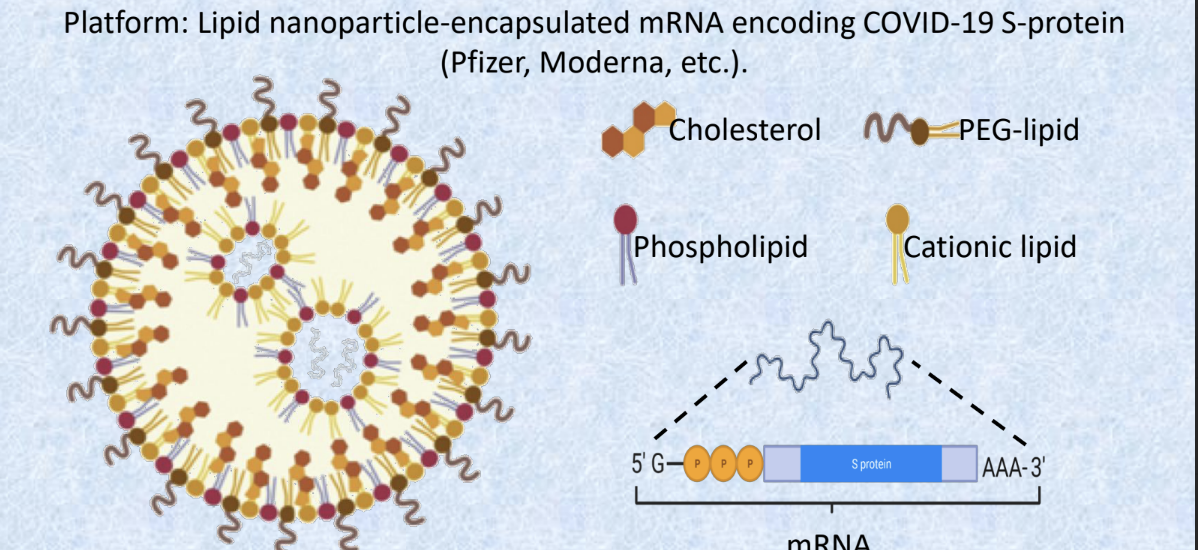
summary: strategy
main strategies for RNA based vaccines
RNA type and delivery system
2 types of RNA
mRNA → basic form of RNA that instructs cells to make viral spike protein
self amplifying RNA (saRNA) → special type of RNA that NOT only gives the instructions but also copies itself inside the cell
2 main delivery systems
lipid nanoparticles (LPNs) → tiny fat bubbles that protect RNA and helps it enter cells
cationic nanoemulsions (CNEs) → positively charged emulsions that can also deliver RNA into cells (cationic helps them stick to negatively charged cell memb.)
